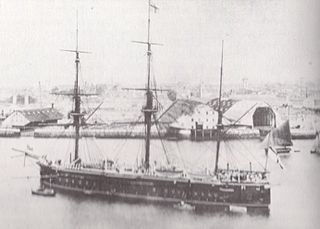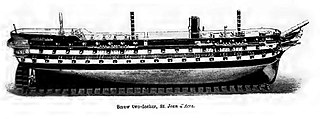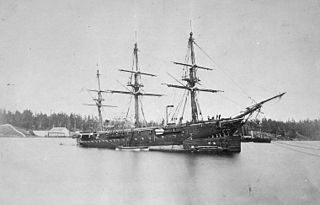
HMS Albion was a 90-gun second-rate ship of the line of the Royal Navy. Ordered in 1839, she was built at Plymouth Dockyard, launched on 6 September 1842, and completed on 23 January 1844. Albion was designed by Sir William Symonds, was the only ship of her class to ever serve as a sailing ship, and the last British two-decker to be completed and enter service without a steam engine. She was the name ship of a class of three second rates—the others being Aboukir and Exmouth.

HMS Liverpool was a fourth-rate frigate of the Royal Navy.

HMS Triumph was a broadside ironclad battleship of the Victorian era, the sister-ship of HMS Swiftsure. These two ships comprise the Swiftsure class of 1870.

HMS Ganges was an 84-gun second-rate ship of the line of the Royal Navy, launched on 10 November 1821 at Bombay Dockyard, constructed from teak. She was the last sailing ship of the Navy to serve as a flagship, and was the second ship to bear the name.
Ten ships of the Royal Navy have been named HMS Royalist:

The Pacific Mail Steamship Company was founded April 18, 1848, as a joint stock company under the laws of the State of New York by a group of New York City merchants. Incorporators included William H. Aspinwall, Edwin Bartlett, Henry Chauncey, Mr. Alsop, G.G. Howland and S.S. Howland.

HMS Pelorus was a 2,330 ton displacement, 21 gun corvette launched on 5 February 1857 from the Devonport dockyard. It was captained at first by Frederick Beauchamp Paget Seymour, then by Henry Boys, and later William Henry Haswell.

HMS Defence was the lead ship of the Defence-class armoured frigates ordered by the Royal Navy in 1859. Upon completion in 1862 she was assigned to the Channel Fleet. The ship was paid off in 1866 to refit and be re-armed and was briefly reassigned to the Channel Fleet when she recommissioned in 1868. Defence had short tours on the North Atlantic and Mediterranean Stations, relieving other ironclads, from 1869 to 1872 before she was refitted again from 1872 to 1874. She became guard ship on the River Shannon when she recommissioned. The ship was transferred to the Channel Fleet again in 1876 and then became guard ship on the River Mersey until 1885. Defence was placed in reserve until 1890 when she was assigned to the mechanical training school in Devonport in 1890. She was renamed Indus when the school adopted that name and served there until sold for scrap in 1935.

HMS Swiftsure was the lead ship of the Swiftsure class battleships built in the late Victorian era. Her sister-ship was HMS Triumph.

HMS Amphion was a second-class cruiser of the Leander class which served with the Royal Navy. She was built at Pembroke Dockyard, being laid down in 1881, launched in 1883 and completed in financial year 1885–86, and then lay in ordinary at Devonport. She was commissioned for the 1887 and 1888 annual manoeuvres. She was recommissioned in December 1888. served in the Pacific until 1890, in the Mediterranean from 1890 to 1895, in ordinary in Devonport from 1895 to 1897 and in the Pacific once more from 1897 to 1904, having a refit in 1900.

HMS Conqueror was a 101-gun Conqueror-class screw-propelled first-rate ship of the line of the Royal Navy. She was launched in 1855, but spent only six years in service before being wrecked on Rum Cay in what was then the colony of the Bahamas in 1861.

The Conqueror-class ships of the line were a class of two 101-gun first rate screw propelled ships designed by the Surveyor’s Department for the Royal Navy.

HMS St Jean d'Acre was the Royal Navy's first 101 gun screw two-decker line-of-battle ship. She served in the Crimean War.

The Astraea class was an eight ship class of protected cruisers built for the Royal Navy during the 1890s. The ships served on a number of foreign stations during their careers, particularly in the waters of the Indian and Pacific Oceans, and around the Cape of Good Hope. Already obsolete by the outbreak of the First World War, most continued to see service in a variety of roles, though rarely in a front line capacity. By the end of the war the majority were being used as training or depot ships, and they were soon sold out of the service and scrapped. However one ship, HMS Hermione, was bought by the Marine Society and used as a training ship until 1940.

HMS Charybdis was a 21-gun Royal Navy Pearl-class corvette launched on 1 July 1859 at Chatham Dockyard.

HMS Royalist was a Satellite-class composite screw sloop of the Royal Navy, built in 1883 and hulked as a depot ship in 1900. She was renamed Colleen in 1913, transferred to the Irish Free State in 1923 and broken up in 1950.
The Greyhound class was a development of the Cruizer-class sloop, and comprised two 17-gun wooden screw sloops. They were both launched in 1859 and saw service with the Royal Navy until 1870. The class was reclassified as corvettes in 1862.

The Commander-in-Chief, Devonport was a senior Royal Navy appointment first established in 1845. The office holder was the Port Admiral responsible for the command and administration of the Devonport Station. The appointment continued until 1900 when the Devonport Station was renamed back to the Plymouth Station and this title in name was abolished.

HMS Simoom was an iron frigate converted to an iron screw troopship. She was laid down in October 1845; however, on 23 April 1847 her frigate design was abandoned as this type of iron warship was considered to be unsuitable against cannon fire and she was ordered to be completed as a troopship. She was launched by Robert Napier and Sons in Govan, Yard No 17, on 24 May 1849, then sold to Collings, Dartmouth in June 1887.
















